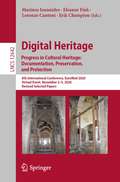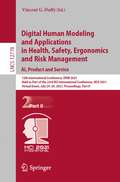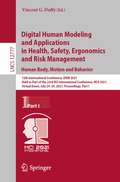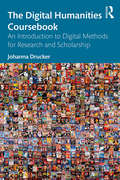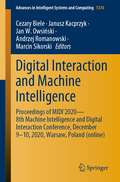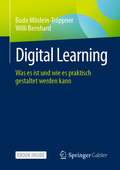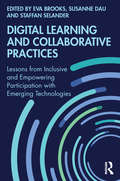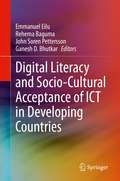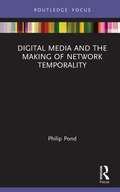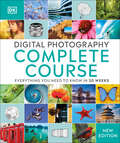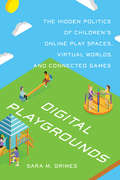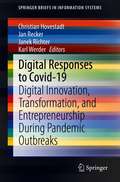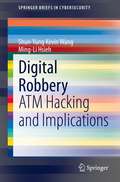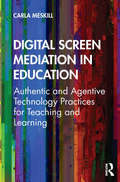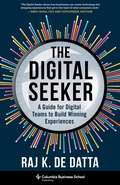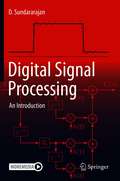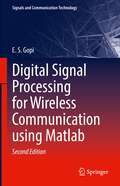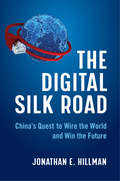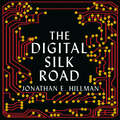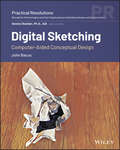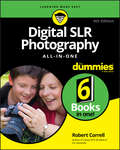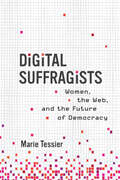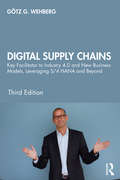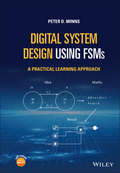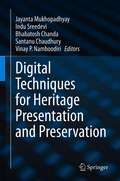- Table View
- List View
Digital Heritage. Progress in Cultural Heritage: 8th International Conference, EuroMed 2020, Virtual Event, November 2–5, 2020, Revised Selected Papers (Lecture Notes in Computer Science #12642)
by Marinos Ioannides Eleanor Fink Lorenzo Cantoni Erik ChampionThis book constitutes the refereed post-conference proceedings of the 8th International Conference on Digital Heritage, EuroMed 2020, held virtually in November 2020.The 37 revised project papers and 30 revised short papers presented were carefully reviewed and selected from 326 submissions. The papers are on topics such as digital data acquisition technologies in CH/2D and 3D data capture methodologies and data processing; remote sensing for archaeology and cultural heritage management and monitoring; interactive environments and applications; reproduction techniques and rapid prototyping in CH; e-Libraries and e-Archives in cultural heritage; virtual museum applications (e-Museums and e-Exhibitions); visualisation techniques (desktop, virtual and augmented reality); storytelling and authoring tools; tools for education; 2D and 3D GIS in cultural heritage; and on-site and remotely sensed data collection.
Digital Human Modeling and Applications in Health, Safety, Ergonomics and Risk Management. AI, Product and Service: 12th International Conference, DHM 2021, Held as Part of the 23rd HCI International Conference, HCII 2021, Virtual Event, July 24–29, 2021, Proceedings, Part II (Lecture Notes in Computer Science #12778)
by Vincent G. DuffyThis two-volume set LNCS 12777 and 12778 constitutes the thoroughly refereed proceedings of the 12th International Conference on Digital Human Modeling and Applications in Health, Safety, Ergonomics and Risk Management, DHM 2021, which was held virtually as part of the 23rd HCI International Conference, HCII 2021, in July 2021.The total of 1276 papers and 241 posters included in the 39 HCII 2021 proceedings volumes was carefully reviewed and selected from 5222 submissions. DHM 2021 includes a total of 56 papers; they were organized in topical sections named: Part I, Human Body, Motion and Behavior: Ergonomics, human factors and occupational health; human body and motion modeling; and language, communication and behavior modeling. Part II, AI, Product and Service: Rethinking healthcare; artificial intelligence applications and ethical issues; and digital human modeling in product and service design.
Digital Human Modeling and Applications in Health, Safety, Ergonomics and Risk Management. Human Body, Motion and Behavior: 12th International Conference, DHM 2021, Held as Part of the 23rd HCI International Conference, HCII 2021, Virtual Event, July 24–29, 2021, Proceedings, Part I (Lecture Notes in Computer Science #12777)
by Vincent G. DuffyThis two-volume set LNCS 12777 and 12778 constitutes the thoroughly refereed proceedings of the 12th International Conference on Digital Human Modeling and Applications in Health, Safety, Ergonomics and Risk Management, DHM 2021, which was held virtually as part of the 23rd HCI International Conference, HCII 2021, in July 2021.The total of 1276 papers and 241 posters included in the 39 HCII 2021 proceedings volumes was carefully reviewed and selected from 5222 submissions. DHM 2021 includes a total of 56 papers; they were organized in topical sections named: Part I, Human Body, Motion and Behavior: Ergonomics, human factors and occupational health; human body and motion modeling; and language, communication and behavior modeling. Part II, AI, Product and Service: Rethinking healthcare; artificial intelligence applications and ethical issues; and digital human modeling in product and service design.
The Digital Humanities Coursebook: An Introduction to Digital Methods for Research and Scholarship
by Johanna DruckerThe Digital Humanities Coursebook provides critical frameworks for the application of digital humanities tools and platforms, which have become an integral part of work across a wide range of disciplines. Written by an expert with twenty years of experience in this field, the book is focused on the principles and fundamental concepts for application, rather than on specific tools or platforms. Each chapter contains examples of projects, tools, or platforms that demonstrate these principles in action. The book is structured to complement courses on digital humanities and provides a series of modules, each of which is organized around a set of concerns and topics, thought experiments and questions, as well as specific discussions of the ways in which tools and platforms work. The book covers a wide range of topics and clearly details how to integrate the acquisition of expertise in data, metadata, classification, interface, visualization, network analysis, topic modeling, data mining, mapping, and web presentation with issues in intellectual property, sustainability, privacy, and the ethical use of information. Written in an accessible and engaging manner, The Digital Humanities Coursebook will be a useful guide for anyone teaching or studying a course in the areas of digital humanities, library and information science, English, or computer science. The book will provide a framework for direct engagement with digital humanities and, as such, should be of interest to others working across the humanities as well.
Digital Interaction and Machine Intelligence: Proceedings of MIDI’2020 – 8th Machine Intelligence and Digital Interaction Conference, December 9-10, 2020, Warsaw, Poland (online) (Advances in Intelligent Systems and Computing #1376)
by Cezary Biele Janusz Kacprzyk Jan W. Owsiński Andrzej Romanowski Marcin SikorskiThis book presents the Proceedings of MIDI’2020 – 8th Machine Intelligence and Digital Interaction Conference, December 9–10, 2020, Warsaw, Poland, held online. The rapid development of artificial intelligence (AI) and its growing applications in many fields, such as intelligent voice assistants, e-commerce (chatbots) or navigation, make end users increasingly exposed to such systems. In a world where technological solutions based on artificial intelligence are created by people for people, the final success or failure of a newly created product depends on the focus on human needs. Therefore, it is important to integrate so far independent scientific areas: broadly defined artificial intelligence and human–technology interaction. This book is intended for specialists in the above fields and attempts to integrate the perspectives of engineers and social scientists. The book is a source of inspiration as well as practical and theoretical knowledge for all readers interested in new trends in the field of user-centered AI solutions.
Digital Learning: Was es ist und wie es praktisch gestaltet werden kann
by Bodo Möslein-Tröppner Willi BernhardDieses Buch gibt dem Leser einen Einblick in die vielfältigen Möglichkeiten, die das Digital Learning bietet. Diese kann er sogleich ausprobieren und selber anwenden. Die Autoren zeigen, wie sich 360-Grad-Lernen im virtuellen Raum umsetzen lässt (Immersive Learning) oder welche nützlichen digitalen Tools beim Lernen und in der virtuellen Zusammenarbeit (Digital Collaboration) verwendet werden können. Der Einsatz der Blockchain-Technologie in der Bildung wird genauso behandelt wie die Umsetzung praktischer digitaler Unterrichtsformen wie der Hybridunterricht als Lernform der Zukunft. Einen weiteren Schwerpunkt bildet die Künstliche Intelligenz (KI) im Digital Learning. Dazu zählen die Anwendung digitaler Sprachassistenten und wissensbasierter Applikationen zur Lösungsfindung ebenso wie die Überprüfung von Home-Based-Prüfungen. Ergänzt werden die vielfältigen Möglichkeiten des digital unterstützten Lernens durch die Anwendung des Digital Storytelling und des spielbasierten Lernens. Nach dem Lesen des Buchs weiß der Leser, was Digital Learning ist und wie es gestaltet werden kann. Für die verschiedensten Ideen und Anforderungen, die sich aus der individuellen Lern- bzw. Lehrsituation ergeben, finden sich einfach umsetzbare digitale Lösungen.
Digital Learning and Collaborative Practices: Lessons from Inclusive and Empowering Participation with Emerging Technologies
by Eva Brooks Susanne Dau Staffan SelanderDigital Learning and Collaborative Practices offers a comprehensive overview of design-based, technology-enhanced approaches to teaching and learning in virtual settings. Today’s digital communications foster new opportunities for sharing culture and knowledge while also prompting concerns over division, disinformation and surveillance. This book uniquely emphasises playful, collaborative experiences and democratic values in a variety of environments—adaptive, augmented, dialogic, game-based and beyond. Graduate students and researchers of educational technology, the learning sciences and interaction design will discover rich theories, interventions, models and approaches for concretising emerging practices and competencies in digital learning spaces.
Digital Literacy and Socio-Cultural Acceptance of ICT in Developing Countries
by Emmanuel Eilu Rehema Baguma John Soren Pettersson Ganesh D. BhutkarThis book discusses the role of human computer interaction (HCI) design in fostering digital literacy and promoting socio-cultural acceptance and usage of the latest ICT innovations in developing countries. The book presents techniques, theories, case studies, and methodologies in HCI design approaches that have been used to foster digital literacy, break the socio-cultural barriers to ICT adoption, and promote the widespread usage of the latest innovations in the health, agriculture, economic, education and social sectors in developing countries. The authors provide insights on how crossing disciplines in HCI such as usability design, user centered design, user experience, anticipated user experience, technology acceptance design, persuasive design, philosophical designs, motivational design, social-cultural oriented designs, and other HCI design approaches have promoted digital literacy and stimulated socio-cultural acceptance and the usage of the latest ICT innovations. The book is relevant in academic, industry and government.Presents theoretical, practical, and socio-cultural approaches to digital literacy challenges in developing countries;Discusses recent ICT and HCI innovations used to transform the health, agriculture, economic, education and social sectors in developing countries;Provides insights on design opportunities and challenges presented in countries where digital literacy is very low and with complex socio-cultural dynamics.
Digital Media and the Making of Network Temporality
by Philip PondThis book presents an exciting new theory of time for a world built on hyper-fast digital media networks. Computers have changed the human social experience enormously. We’re becoming familiar with many of the macro changes, but we rarely consider the complex, underlying mechanics of how a technology interacts with our social, political and economic worlds. And we cannot explain how the mechanics of a technology are being translated into social influence unless we understand the role of time in that process. Offering an original reconsideration of temporality, Philip Pond explains how super-powerful computers and global webs of connection have remade time through speed. The book introduces key developments in network time theory and explains their importance, before presenting a new model of time which seeks to reconcile the traditionally separate subjective and objective approaches to time theory and measurement.
Digital Photography Complete Course: Learn Everything You Need to Know in 20 Weeks (DK Complete Courses)
by DKGrab your camera and learn everything you need to know to improve your photography in just 20 weeks.Introducing Digital Photography Compete Course - the perfect beginner&’s learning program for any aspiring photographer, this photography book aims to teach you everything you need to know about photography in just 20 weeks, through easy-to-understand tutorials. It&’s time to start using your camera to its full potential, and this photography book for beginners can help you do just that. Combining tutorials, step-by-step photo shoots, practical assignments, and fun Q&As, this brilliant book on photography can help you untangle photographic jargon such as aperture, exposure, shutter speed, and depth-of-field; teach you top tips and tricks surrounding the range of modes on bridge and system cameras, and help you to master composition for that perfect photo!Become a photography expert in no time, as you explore:- Review, practice and experiment sections to put photography knowledge to the test - Technical concepts are broken down and explained in simple, accessible language - Easy-to-read diagrams and illustrations to highlight key theories- The latest technological and creative developments in digital photography and image manipulationDK&’s Digital Photography Complete Course is a must-have book for photography lovers of all ages, whether you&’re a photography or art student seeking to learn more about the subject, or a photography beginner looking to improve your own digital photography techniques. Doubling up as the perfect photography gift book for beginners, Digital Photography Compete Course will help you use your camera to its full potential so that you don&’t just take good pictures – you take great ones!
Digital Playgrounds: The Hidden Politics of Children’s Online Play Spaces, Virtual Worlds, and Connected Games
by Sara GrimesDigital Playgrounds explores the key developments, trends, debates, and controversies that have shaped children’s commercial digital play spaces over the past two decades. It argues that children’s online playgrounds, virtual worlds, and connected games are much more than mere sources of fun and diversion – they serve as the sites of complex negotiations of power between children, parents, developers, politicians, and other actors with a stake in determining what, how, and where children’s play unfolds. Through an innovative, transdisciplinary framework combining science and technology studies, critical communication studies, and children’s cultural studies, Digital Playgrounds focuses on the contents and contexts of actual technological artefacts as a necessary entry point for understanding the meanings and politics of children’s digital play. The discussion draws on several research studies on a wide range of digital playgrounds designed and marketed to children aged six to twelve years, revealing how various problematic tendencies prevent most digital play spaces from effectively supporting children’s culture, rights, and – ironically – play. Digital Playgrounds lays the groundwork for a critical reconsideration of how existing approaches might be used in the development of new regulation, as well as best practices for the industries involved in making children’s digital play spaces. In so doing, it argues that children’s online play spaces be reimagined as a crucial new form of public sphere in which children’s rights and digital citizenship must be prioritized.
Digital Responses to Covid-19: Digital Innovation, Transformation, and Entrepreneurship During Pandemic Outbreaks (SpringerBriefs in Information Systems)
by Christian Hovestadt Jan Recker Janek Richter Karl WerderThis book presents ten essays that examine the potential of digital responses to the COVID-19 pandemic. The essays explore new digital concepts for learning and teaching, provide an overview of organizational responses to the crisis through digital technologies, and examine digital solutions developed to manage the crisis. Scientists from many disciplines work together in the fight against the virus and its numerous consequences. This book explores how information systems researchers can contribute to these global efforts. The book will be of interest to researchers and scholars in the field of digital business and education.
Digital Robbery: ATM Hacking and Implications (SpringerBriefs in Cybersecurity)
by Shun-Yung Kevin Wang Ming-Li HsiehThis book begins with a broader discussion of cybercrime and attacks targeting ATMs and then focuses on a specific type of cybercrime named “ATM Hacking.” It discusses ATM Hacking from a more full scope of aspects, including technology, modus operandi, law enforcement, socio-economic and geopolitical context, and theory development. After unpacking a classic case of ATM Hacking and its modus operandi, implications for cybersecurity and prevention, intra- and inter-agency collaboration, and theory development are presented.This book also demonstrates the analysis of extensive qualitative data collected from a high-profile case in which European criminal group hacked into a London voice mail server belonging to a Taiwanese financial institution – First Commercial Bank,. Then it programmed dozens of ATMs to “spit out” millions of dollars of cash. The successful crackdown on this type of crime is rare, if not unique, while the number of similar crimes has increased enormously in recent years and the trend seem to continue unabatingly. Further, the implications go beyond a country or a continent. Intra- and inter-agency collaboration among players of law enforcement is essential to the case especially in the police context of “turf jealousies.”The authors seek to document the ways in which agencies collaborate, as well as the perceived benefits and challenges of cooperation. Whether the broader political and contextual climates in which these agencies operate, limit the extent to which they can cooperate.This book is useful as a reference for researchers and professionals working in the area of cybercrime and cybersecurity. University professors can also use this book as a case study for senior seminars or graduate courses.
Digital Screen Mediation in Education: Authentic and Agentive Technology Practices for Teaching and Learning
by Carla MeskillDigital Screen Mediation in Education explores the complex role of visual mediation in today’s digitally enhanced classrooms. While the notion that technology tools have agency—that they act to induce learning—pervades contemporary conversations about pedagogy, this unique volume reframes instructional agency around teachers. The book’s theoretically reinforced and multidisciplinary approach to enhancing effective instruction with screen-based technologies spans aesthetics, technical knowledge, teacher empowerment, social media, and beyond. Researchers in educational technology, instructional design, online learning, and digital pedagogies as well as prospective and practicing educators will find a rigorous treatment of how skilled, thoughtful teaching with, through, and around digital screens can bring about successful learning outcomes.
The Digital Seeker: A Guide for Digital Teams to Build Winning Experiences
by Raj K. DattaThe internet was supposed to connect us to endless possibilities. So why do we keep ending up browsing the same old sites and best-seller lists? When sellers don’t offer potential customers a compelling digital experience, consumers miss out on great products—and businesses miss a vital opportunity to grow.Raj K. De Datta, the founder of a company that powers digital-commerce experiences for many of the world’s biggest brands, offers an actionable playbook for companies looking to deliver better digital experiences. His key insight is that exceptional digital experiences are much more than marketplaces. They don’t just serve customers’ transactional needs but rather address the deeper problems for which they seek solutions. They are built on a digital-experience platform that provides agile, personalized, scalable performance. And they are created by product-centric digital teams, not traditional organizations.The Digital Seeker distills key lessons from the compelling stories of innovative businesses: not just tech companies but companies spanning a wide range of industries, including amusement parks, fashion, sports, health care, distribution, and the public sector. De Datta defines and explains the power of the seeker-centric philosophy—translating it into a core operational playbook for digital teams to achieve transformative results.Importantly, this book also offers crucial insights into the impact of the COVID-19 pandemic on our digital lives and the long-term effects it will have on digital experiences of the future.
Digital Signal Processing: An Introduction
by Dr. D. SundararajanThis textbook for a one semester introductory course in digital signal processing for senior undergraduate and first year graduate students in electrical and computer engineering departments is concise, highly readable, and yet provides comprehensive coverage of the topic. Each new topic is presented with examples and figures. The highly mathematical content of the topic is presented lucidly to make the learning the subject easier. Practical aspects of the subject are clearly indicated so that the student can apply the principles in real applications. Matlab programs for FIR filter design are provided as supplementary material online.
Digital Signal Processing for Wireless Communication using Matlab (Signals and Communication Technology)
by E.S. GopiThe updated book presents Matlab illustrations on various digital signal processing (DSP) techniques such as random process, time varying wireless system model, and detection and estimation theory used in wireless communication. The book also covers recent wireless techniques like OFDM, massive MIMO techniques, non-orthogonal multiple access, millimeter wave MIMO, full duplex, cognitive radio, co-operating communication, unmanned aerial vehicles etc. This book is suitable for those who are doing basic and applied research in digital signal processing for wireless communication.
The Digital Silk Road: China's Quest to Wire the World and Win the Future
by Jonathan E. HillmanAn expert on China’s global infrastructure expansion provides an urgent look at the battle to connect and control tomorrow’s networks.From the ocean floor to outer space, China’s Digital Silk Road aims to wire the world and rewrite the global order. Taking readers on a journey inside China’s surveillance state, rural America, and Africa’s megacities, Jonathan Hillman reveals what China’s expanding digital footprint looks like on the ground and explores the economic and strategic consequences of a future in which all routers lead to Beijing.If China becomes the world’s chief network operator, it could reap a commercial and strategic windfall, including many advantages currently enjoyed by the United States. It could reshape global flows of data, finance, and communications to reflect its interests. It could possess an unrivaled understanding of market movements, the deliberations of foreign competitors, and the lives of countless individuals enmeshed in its networks. However, China’s digital dominance is not yet assured. Beijing remains vulnerable in several key dimensions, the United States and its allies have an opportunity to offer better alternatives, and the rest of the world has a voice. But winning the battle for tomorrow’s networks will require the United States to innovate and take greater risks in emerging markets. Networks create large winners, and this is a contest America cannot afford to lose.
The Digital Silk Road: China's Quest to Wire the World and Win the Future
by Jonathan E. HillmanIts vast infrastructure projects now extend from the ocean floor to outer space, and from Africa's megacities into rural America. China is wiring the world, and, in doing so, rewriting the global order.As things stand, the rest of the world still has a choice. But the battle for tomorrow will require America and its allies to take daring risks in uncertain political terrain. Unchecked, China will reshape global flows of data to reflect its interests. It willdevelop an unrivalled understanding of market movements, the deliberations of foreign competitors, and the lives of countless individuals enmeshed in its systems. Networks create large winners, and this is one contest that democracies can't afford to lose.Taking readers on a global tour of these emerging battlefields, Jonathan Hillman reveals what China's digital footprint looks like on the ground, and explores the dangers of a world in which all routers lead to Beijing.
Digital Sketching: Computer-Aided Conceptual Design (Practical Revolution)
by John BacusLearn to apply new digital design technologies at your own firm with this practical and insightful resource Digital Sketching: Computer-Aided Conceptual Design delivers a comprehensive and insightful examination of how architects and other design professionals can best use digital design technology to become better designers. Celebrated professional, professor, and author John Bacus provides readers with practical and timely information on emerging digital design technologies and their effect on professional practice. By focusing on the big picture, this rigorous survey of conceptual design technology offers professionals realistic strategies for reclaiming time for design in the ever increasing speed of project delivery. This book helps architects (and others like them) learn to use digital sketching techniques to be better designers, right from the project’s very first sketch. As part of the groundbreaking Practical Revolutions series of books, Digital Sketching furthers the conversation of the practical deployment of emerging technologies in the building industries. This book provides readers with the information they need to evaluate digital design technology and decide whether or not to adopt and integrate it into their own processes. Readers will receive: An accelerated and accessible introduction to a highly technical topic Practical and applicable guidance on how to adapt a firm’s business to adopt new technology without losing the benefit of existing intuition, skill, and experience. Real world implementations of specific techniques in the form of illuminating case studies that include results and lessons learned Perfect for professional architectural designers, Digital Sketching also belongs on the bookshelves of interior designers, landscape architects, urban planners, contractors, and specialty fabricators of every kind. A disciplined sketching practice, especially through the digital methods discussed in this book, is a transformational benefit to anyone who designs and builds for a living.
Digital SLR Photography All-in-One For Dummies
by Robert Correll6 Books in one! Boost your DSLR photography skills with this amazing book When you're investing in top-notch camera equipment, it's also time to build top-notch photography skills that help you create the stunning images you see in your mind. This book gets you started on the path to capturing incredible photos of life's most precious moments. Cut through the jargon and techspeak as you get down to the essentials of taking control of your powerful camera and leaving the days of washed-out and blurry photos behind. 6 Books Inside… Review digital photography basics and camera controls Get the right lens for the shot Take creative control of exposure settings Shed some light on your subject Perfect the picture with editing Follow recipes for portraits, landscapes, close-ups, and action shots
Digital Suffragists: Women, the Web, and the Future of Democracy
by Marie TessierWhy women&’s voices are outnumbered online and what we can do about it, by a New York Times comment moderator.If you&’ve read the comments posted by readers of online news sites, you may have noticed the absence of women&’s voices. Men are by far the most prolific commenters on politics and public affairs. When women do comment, they are often attacked or dismissed more than men are. In fact, the comment forums on news sites replicate conditions of the offline and social media worlds, where women are routinely interrupted, threatened, demeaned, and called wrong, unruly, disgusting, and out of place. In Digital Suffragists, Marie Tessier—a veteran journalist and a New York Times comment moderator for more than a decade—investigates why women&’s voices are outnumbered online and what we can do about it. The suffragists of the early twentieth century were jailed for trying to vote. Can a twenty-first century democracy be functional when half of the population is not fully represented in a primary form of political communication? Tessier shows that for online comments, it&’s a design problem: the linear blog comment formula was based on deeply gender-biased assumptions. Technologies designed with a broad range of end users in mind, she points out, are more successful and beneficial than those that reflect the designer&’s own habits of mind. Tessier outlines benchmarks for a more democratic media, all of which stem from one fundamental idea: media must adopt gender and racial representation as key performance indicators. Equal speaking time for women is a measure of democracy.
Digital Supply Chains: Key Facilitator to Industry 4.0 and New Business Models, Leveraging S/4 HANA and Beyond
by Götz G. WehbergThis book provides a practical guide to digital supply chain modelling, demonstrating an agile approach to how such models can be applied to any manufacturing company to build competitive advantage, facilitate new business models and drive towards Industry 4.0. The agile approach of the book provides an attractive alternative to the conventional country-by-country deployment of S/4 HANA and other relevant technologies. This book contains the expertise Gotz G. Wehberg has amassed over 20 years as a senior partner in a leading consulting company, working across industries and with globally recognized clients, advising on digitization. In it, he explains the scientific roots of digital supply chain management such as holism, cybernetics, self-organization and evolutionary theory to inform a deep understanding that can drive a supremely innovative strategy for Industry 4.0. Beyond strategy, Wehberg introduces the practical tools and technologies used in supply chain modelling, for example, sensors, big data, artificial intelligence and the Internet of Things, as well as a reference framework that categorizes the technologies, together with the latest concepts and tools, such as DDMRP, predictive S&OP, pattern recognition, autonomous logistics and Lean. This framework supports decision making for developing supply chains in an end-to-end and cross-functional fashion, providing clear guidance for executives and managers on how to design supply chains for the future.
Digital System Design using FSMs: A Practical Learning Approach
by Peter D. MinnsThis is a complete update of the author's earlier book, FSM-Based Digital Design using Verilog HDL (Wiley 2008). Whilst the essential foundation content remains, the book has been considerably refreshed to cover the design of Finite State Machines (FSM) in place of Microprocessors, using a novel form of State Machines based on Toggle Flip Flops (TFF) and Data Flip Flops (DFF). It follows a Linear Programmed Learning approach, enabling the reader to learn at their own pace, and to design their own FSM based systems.
Digital Techniques for Heritage Presentation and Preservation
by Jayanta Mukhopadhyay Indu Sreedevi Bhabatosh Chanda Santanu Chaudhury Vinay P. NamboodiriThis book describes various new computer based approaches which can be exploited for the (digital) reconstruction, recognition, restoration, presentation and classification of digital heritage. They are based on applications of virtual reality, augmented reality and artificial intelligence, to be used for storing and retrieving of historical artifacts, digital reconstruction, or virtual viewing.The book is divided into three sections: “Classification of Heritage Data” presents chapters covering various domains and aspects including text categorization, image retrieval and classification, and object spotting in historical documents. Next, in “Detection and Recognition of Digital Heritage Artifacts”, techniques like neural networks or deep learning are used for the restoration of degraded heritage documents, Tamil Palm Leaf Characters recognition, the reconstruction of heritage images, and the selection of suitable images for 3D reconstruction and classification of Indian land mark heritage images. Lastly, “Applications of Modern Tools in Digital Heritage” highlights some example applications for dance transcription, architectural geometry of early temples by digital reconstruction, and computer vision based techniques for collecting and integrating knowledge on flora.This book is mainly written for researchers and graduate students in digital preservation and heritage, or computer scientists looking for applications of virtual reality, computer vision, and artificial intelligence techniques.
